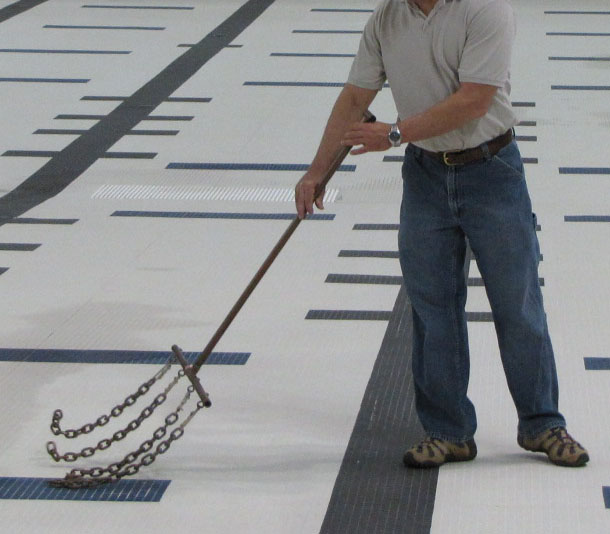By Donato Pompo, Ceramic Tile and Stone Consultants
A common symptom I come across in investigations is ceramic or stone tile (“tile”) that sounds hollow. A simple way to check for the sound in question is to tap on the tiles with a hard object such as a steel ball bearing. Chains or special sounding devices can be used for larger areas. If the tile is well bonded (i.e. attached to the concrete substrate), it will have a high-pitched sound. If you hear a lower-pitched or a hollow sound, this can indicate that tiles have debonded, or were never bonded, somewhere within the tile assembly.
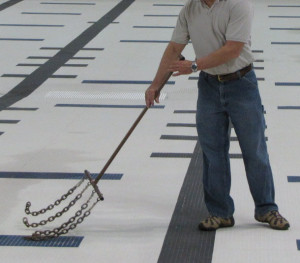

A low tone is not a cause for immediate panic, however. A low-pitched sound can also occur and not signify there is a problem – the type of sound you hear also depends on the configuration of the tile assembly. For example, when tile is installed over a less-dense substrate — as in the case of wood, a non-bonded mortar bed, a sound-control mat or other membrane, or over a steel- framed wall — tapping often produces a hollow-sounding tone even though the tile may be well attached. Depending on the tile assembly configuration, the hollow sound might be a lower or higher-pitched sound, and vice-versa for the solid sound.
So how does one determine whether the elusive “hollow” sound is the bad type?
If an entire tile installation sounds hollow it may be a result of the type of substrate that was used and not an indication of a problem. In my experience as an investigator I’ve rarely seen an entire installation that’s debonded unless there are other symptoms like loose or cracked tile and grout.
What signals debonding is a differential in sound from one area of an installation to another, or from one portion of the tile to another. Let me explain: if I’m investigating a 1,500 square foot tile floor in a restaurant and I sound the entire area, calculating that only 75% of the tiles sound “solid” and 25% sound hollow, this can raise a red flag.
The hollow-sounding areas could signal several things: the thin-set adhesive could have debonded from the back of the tiles, or the thin-set could have debonded from the substrate. If the substrate is a bonded mortar bed, it’s possible that the mortar bed has debonded from the concrete slab.
Notice if the hollow-sounding tiles are grouped together or are the spread out randomly — and is there pattern? Does the whole tile sound hollow or does only a portion of the tile sound hollow? In this instance, one also wonders about the solid-sounding tiles: do they have the same problem but haven’t debonded yet and might at a later date?
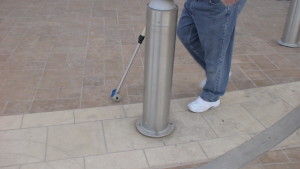

Spot-bonding
Hollow sounds produced by tapping tiles can also be a result of an improper installation method called spot-bonding. Spot-bonding is when an installer applies “spots” of adhesive on each corner of a tile and one in the center, and then presses it into place. This leaves voids under the tile, and ultimately throughout the entire installation, which can lead to big problems. When this method has been used you’ll hear the hollow sound where there is no adhesive (the voids) and you’ll hear solid sounds where the tile is spot-bonded.
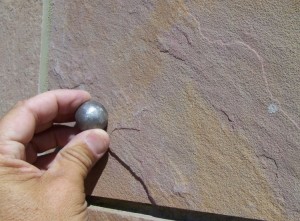

The spot-bonding method is a problem in several ways. It does not meet industry standards for coverage either for residential floors (80% contact required) or commercial floors, exterior applications and interior wet applications (95% contact required) — all with no voids greater than 2 square inches and full thin-set contact at all tile edges and corners.
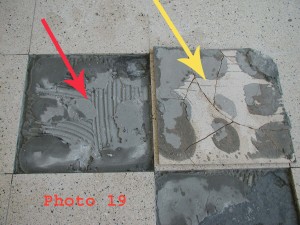

Spot-bonding also reduces the bond strength of the tile and its attachment to the substrate, making it more susceptible to stress and causing debonding under certain conditions. Voids that occur with spot-bonding become pockets for water and moisture to collect, which could lead to efflorescence and other moisture-related problems. The lack of support beneath the voids also make the tile more vulnerable to damage from live loads such as falling heavy objects, heavy equipment, rolling vehicles, loaded dollies, carts, etc.
Spot bonding is only appropriate when used either for mechanically anchoring stone slabs or in tile applications using an epoxy adhesive for a ventilated wall system.
Forensic investigation
The only way to substantiate if tiles have debonded and to determine what has caused it to debond is to remove tiles with the various conditions from different areas of the installation for comparison – some that are hollow sounding and some that are solid sounding. By extracting pieces of tile and substrate(s) you can determine what’s different in the assemblies of the hollow vs. solid sounding tiles and, determine whether individual defective tiles can be simply repaired or if the entire installation needs to be replaced.
Removing solid-sounding tiles not only shows differences in how it was installed, but can also show similarities to hollow sounding tiles. Sometimes solid sounding tiles have also been improperly installed or compromised, but have not been subjected to the same stresses as tiles in other areas; these tiles may look okay, but they may eventually debond and need to be repaired. On the other hand, you may find that a bonded mortar bed has debonded from the slab, for one reason or another, causing the hollow sound, but that condition will not cause any resultant problems in terms of the long term performance of the tiled floor.
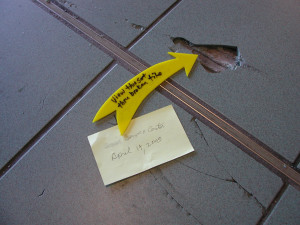

Causes for debonded tiles
Some common reasons why tiles debond are:
- The concrete substrate is not properly prepared. Concrete curing compounds may act as bond breakers or the concrete surface is too dense and doesn’t absorb moisture well enough to allow thin-set to achieve an adequate bond.
- The backs of the ceramic or stone tiles are not properly cleaned before application. Dirt and manufacturing residues are contaminants and act as bond breakers.
- Thin-set mortar adhesives will “skin over” during the curing stage and will lose tackiness, thereby reducing the bond to the tile. Improper slaking or mixing causes this; so does applying thin-set over a too-porous substrate.
- Other factors that contribute to debonding are excessive floor or wall deflection (vertical movement) and the lack of movement joints (expansion joints). This can result in tile tenting to release pressure from the tile assembly.
Conclusion
The best way to ensure that you don’t end up with tile and stone installation problems is to verify that installers are following industry standards. The Certified Tile Installer program through CTEF and the Advanced Certifications for Tile Setters (ACT) program validate basic – and in the case of ACT – advanced skills possessed by the tile setter. Visit www.ceramictilefoundation.org for more information.
The University of Ceramic Tile and Stone (UofCTS) offers a convenient and practical online education course for tile installers (setters and helpers) to learn the current industry thin-set and substrate preparation standards. Visit www.CTaSC.com for more information.
It’s very important to have clearly-written architectural specifications providing for specific quality assurance requirements to ensure that the right products and methods are used for the intended applications. Installers should have their own internal quality control plan as a way to avoid potential problems and to catch deficiencies early on so they don’t become a costly problem. The quality control process in itself becomes a platform for training installers to make sure they understand and follow industry standards. Make sure you are up to date on, and follow, the industry standards, and that you read and follow the manufacturers’ directions to avoid costly problems down the road.
Donato Pompo CTC CDT CMR MBA has worked in the ceramic tile and stone industry for over 35 years as a union installer, an importer and distributor for, and a sales manager for an international manufacturer of installation products. Donato has operated his own forensic and consulting business for over 12 years and serves on a number of industry committees. For more information on Donato and his company, Ceramic Tile and Stone Consultants, visit www.CTaSC.com or email [email protected].
Editorial Director and Senior Writer for TileLetter and TileLetter ARTISAN
Lesley Goddin has been writing and journaling since her first diary at age 11. Her journey has taken her through a career in publishing and publicity, landing her the editor position of TileLetter and its special publications in 2006. Her goal is to educate, inspire, recognize and encourage those in the tile industry -- especially the tile and stone contractor.


